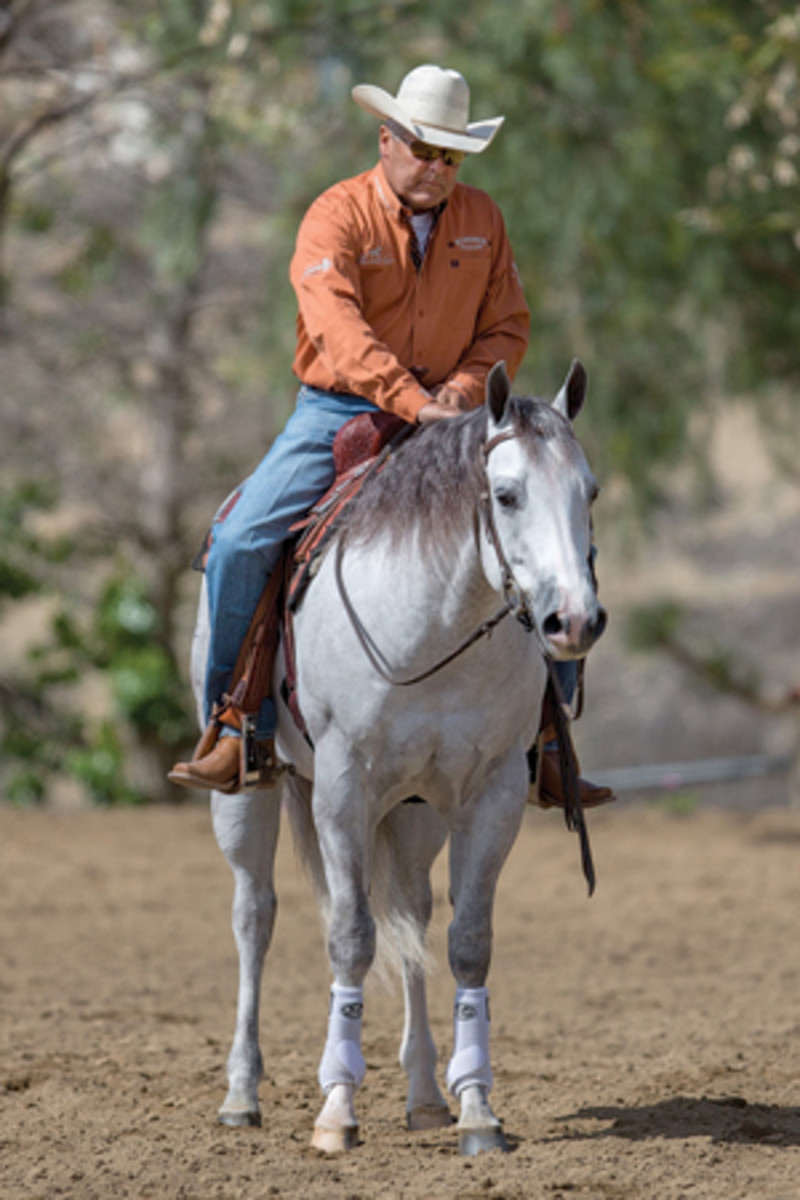When your horse resists, you may be tempted to go big: bigger bit, bigger spurs, and bigger cues. That’s the wrong response. Go back to basics in a snaffle, soften your hand and leg cues, and give your horse a big reward to overcome his resistance and ratchet up his responsiveness. You keep asking…but your horse keeps saying, “No.” Maybe it’s to jogging slow. Or turning fast. Or, well, you name it.

The temptation? To go big: bigger bit, bigger spurs, bigger cues. But that’s wrong in a big way. Because when your horse says, “No,” it’s usually for a reason. He either has a physical problem (which is why you should rule that out first, with your vet) or else thinks he can’t do it.
That could be because he doesn’t understand what you’re asking for or lacks the skills to comply. The result? A lack of confidence in himself, and in you, which can make him tense and afraid.
Unfortunately, because we humans are always in a hurry, we’re always looking for a shortcut. And going big is just that—a shortcut that short-changes your horse, by masking the core problem.
When he’s not responding, what he really needs are these three things: 1) a softer bit; 2) softer hands (and legs); and 3) a bigger reward.
1. Softer Bit
That’s right: When your horse says no, you need to find out why. And you do that by going back to basics in a snaffle to get to the root of his problem. Then you have to fix it, and slowly move forward. No, it’s not the fast way. But it’s the right way.

I know—it’s counterintuitive. When your horse wants to go fast, and leans into your hands when you try to rate his speed, a bit with longer shanks and a bigger mouthpiece sounds as though it makes sense.
It’s the same when you have a horse that wants to poke his nose out in the turnaround and lean on your hands. Or root at the bit, rather than yield to it.
Your initial thought is that bigger will make him back off. But take it from me: I have a wall full of bigger bits, but my go-to fix-it tool is a snaffle. That’s because a horse that’s leaning into your hands or ignoring you is a horse that’s tense, out of balance, and missing something in his education.
When you reach for the tougher hardware, you don’t fix those core problems. In fact, you exacerbate them. I see a lot of riders do that, though. For instance, with a horse that won’t jog or lope slowly, they’ll grab a big bit and keep jerking the horse back. Wrong! That’ll just make him tense, scared, and irritable, which is not going to make him want to go slow.
What’s better: Outfit your horse in a snaffle, and s-l-o-w your mind and body down. When you do that, he’ll do the same. And that’s where the second tool to make your horse more responsive comes in.
2. Softer (and Slower) Hands (and Legs)
When your horse’s mind and body slow down, he’ll be relaxed and receptive to learning. That means he’ll be able to go slow (or do anything well and willingly). But he’ll only get that way if you soften and slow down your hands and legs.

Jerking and jabbing gets you nowhere. Again, that’s counterintuitive when you’re asking your horse to go slow, and he responds by speeding up. You get impatient, and want to stomp on the “brakes” rather than giving them a gentle tap. But that backfires.
Alternative: When you lighten your feel on the reins, and make your hands and legs move slowly and deliberately, you’ll soften your horse’s mouth and sides, not to mention his attitude. He’ll gain confidence when he knows you’re not going to punish him with sharp jerks and jabs, so his resistance will melt and he’ll become more responsive. You’ll initiate a conversation with your reins and legs rather than a shouting match!
Ask him to yield to bit pressure with a feather-light touch at the walk and jog, and to move forward into the bit with the lightest touch of leg pressure. As he complies, he’ll rock his weight over his hind end, so he’s balanced. Then be sure to give him the next component.
3. A Bigger Reward
The instant you feel even the slightest attempt on his part to yield to the bit, give him a big release. (This is one time where big is good!) By that, I mean release all pressure on the bit, as well as from your leg cues. Plus, give him a pat. Make a big deal out of his reaction so he knows exactly what you’re asking for. That’s how you’ll accelerate his learning. (And his responsiveness!)

Every day, you can ask for a little bit more. If you have a blip because your horse is having a bad day, don’t panic. Find a good place to quit, reward him, and ask again tomorrow.
Your progress will be incremental. But your horse’s foundation and education will be rock-solid. And his responsiveness will soar. Sure, this all takes time. Lots of it. Which is why so many riders (and trainers) would rather go big rather than go back to the basics.
Note: If you lack the skills to overcome a problem, invest some time and money in lessons from a reputable trainer. Do it for your horse. It takes time to make a good one. But you both will be rewarded when you invest it.
A multiple AQHA world champion, Avila has also won three NRCHA Snaffle Bit Futurities, the NRHA Futurity, and two World’s Greatest Horseman titles. He received the AQHA Professional Horseman of the Year honor. His Avila Training Stables, Inc., is in Temecula, California. Learn more at bobavila.net.






